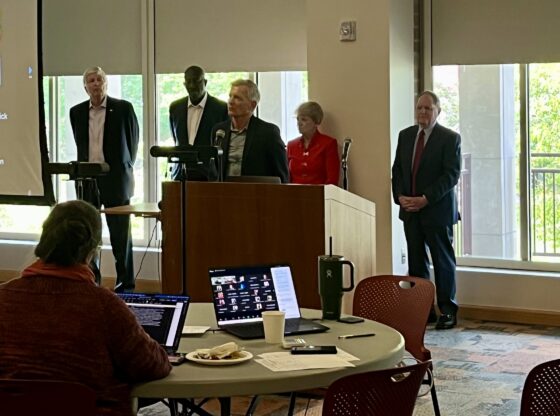A media expert yesterday spoke in the Cable Center about political advertisements on television.
John Splaine, the Amos B. Hostteter Jr. Chair in the School of Communication and the Office of the Provost, opened with a clip with comments from Lesley Stahl of CBS News, who narrated a video clip of Ronald Reagan at a handicapped event.
She said Reagan had decreased funding for the handicapped organizations, but his campaign supporters thanked her for the “free commercial.” They noted that people didn’t hear what she was saying about Reagan; rather, they saw the pictures, which spoke louder than words.
“The problem is that images contain data, but they don’t contain information,” said Dr. Splaine.
He used a model to deconstruct several commercials using the acronym, SNAILS. It stands for symbols, narration, angles, implied meaning, lighting and scare tactics.
Splaine showed ads from past political television campaigns, such as “Morning in America” from Reagan’s 1984 presidential campaign, “Red Phone” by the supporters for Walter Mondale and the “Daisy” ad, a commercial featuring a young girl blowing petals off of a daisy, the ad then cuts away to a Nulear bomb detination.
Splaine showed the commercials and then discussed the components with the audience members. They exchanged comments on lighting effects on a person’s persona, such as a shadow denotes evil or untruthfulness.
Another controversial advertisement was the “Revolving Door” commercial which made an indirect reference to Willy Horton, an inmate and rapist. In a video clip played by Splaine, scholar Kathleen Hall Jameson deconstructed the advertisement. The commercial, funded by the Bush-Quayle campaign in 1988 attacked presidential candidate Michael Dukakis on his supposedly lax laws in Massachusetts where he was governor.
Jameson argued that the advertisement was blatantly incorrect. It was sho at a Utah’ prison used to portray convicts who were going freely through a revolving door. She explained that the ad was “pseudo-entertainment” meant to “sustain disbelief.”
According to Splaine, about 75 percent of people get their political information from television.
“Television requires that you don’t think—or works best if you don’t think at all,” Splaine said.
This spring, Splaine will be teaching two new courses in a collaborative effort with the School of Communication, The Cable Center and C-Span.
“Political Communication: Television and Politics” will be offered as a travel course during the spring interterm March 18-22 in Washington, D.C. Students will be able to meet with journalists and political leaders. Also, students will attend a White House briefing and meet with White House Press Secretary Ari Fleischer.
In the spring quarter, Splaine will teach an interactive course from a C-SPAN studio in Washington, while students in Denver will attend class at The Cable Center.
The course is entitled “Polictical Communication: TV and the Presidency” and will explore the effects of television and the media on presidents. Students will have the opportunity to view videos from the C-SPAN library in Washington.










